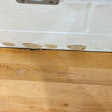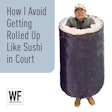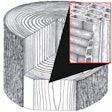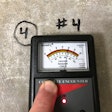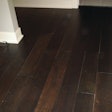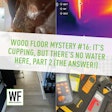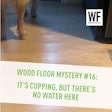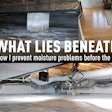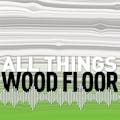The Problem
I was called to inspect a solid ¾-by-3¼-inch factory-finished Brazilian cherry floor that cupped about four to five months after being installed during a remodel in a Florida home.
The Procedure
A total of 1,287 square feet of the wood flooring had been installed on the first floor, which had an on-grade concrete subfloor. The living and dining room carpeting had been removed, and new wood flooring was nailed to 5⁄8-inch-thick plywood placed on roofing felt on top of the concrete subfloor. The family room floor was nailed to ¼-inch-thick plywood over existing wood flooring, which was glued directly to the concrete. The two areas of wood flooring were separated by several rooms of stone flooring that had been set into a ½-inch-thick mortar bed.
The Cause
When I entered the home, the cupping throughout the wood flooring was immediately noticeable. The cupping measured 0.02 to 0.03 inch, with the worst cupping found in the family room, where the new floor had been installed over the existing wood flooring.
The relative humidity (RH) in the home was 51 percent, with a temperature of 77 degrees Fahrenheit. In Florida, a 51 percent RH is within the normal range. Wood moisture content (MC) readings using an invasive probe moisture meter found 10 and 11 percent MC on the top of the boards, 12 to 13 percent near the center and 15 to 16 percent near the bottom of the boards. An invasive probe moisture meter with insulated pins into the plywood subfloor found 18 to 21 percent MC. I then cut out the floor in each area to observe the installation sandwich that was underneath. In both areas, no moisture barriers were found, only roofing felt.
The wood moisture tests confirmed the origination of the excessive moisture and cause of the moisture imbalance to be the concrete subfloor. A concrete moisture meter showed moisture readings of 4 to 5 on the relative scale of 0 to 5, or 80 to 100 percent relative concrete MC.
The myth, or misunderstanding, leading to the failure of both of these floors was that asphalt roofing felt is a vapor barrier. Roofing felt may retard concrete vapor emissions, but it does not stop vapor from reaching wood flooring.
How to Fix the Floor
To protect this floor from concrete vapor emissions, the concrete surface must be sealed. The only way to do that is by removing the existing floors and sealing the concrete surface according to acceptable industry practices and guidelines. Methods to do this are outlined well in the NWFA's Installation Guidelines. Options listed in the Guidelines include: a minimum of 6-mil construction-grade polyethylene film with a perm rating of 0.15 or less, two layers (both installed with adhesive) of #15 asphalt saturated felt paper, or one of the many liquid or trowel-applied membranes now available. Also be sure to comply with local building codes.
In the Future
Simply said, roofing felt is not a vapor barrier, and believing that it is can be costly. It cannot be used alone over concrete. Concrete subfloors are the most common subfloors across the South from Florida to California, and the number of wood flooring failures I see that are attributed to concrete vapor emissions is staggering. Even if an existing wood floor appears to be performing fine over the concrete subfloor, don't assume a new wood floor will do the same.




















